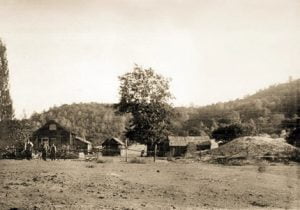The Me-Wuk Indians of the Buena Vista Rancheria are an integral part of California’s Native American history. They lived in and around what is now Amador County for thousands of years. The Oliver family has roots in Amador County as early as 1817. As a result of the Mission Period, Gold Rush and then diseases that Indian people had never been exposed to, the Me-Wuks’ numbers shrunk dramatically over the last three centuries.
By the late 19th Century, the Me-Wuks in the Amador County area were reduced to a smattering of individual families. The Buena Vista Band and its descendents lived through some of the most horrific times in American history…from Casus Oliver and his mother escaping Mission San Jose, to continuing to practice their culture when it was forbidden. Casus Oliver came to Amador County with his mother and joined the settlement of Upusani.
The Buena Vista Rancheria of Me-Wuk Indians of California is a federally recognized Indian tribe. The Tribe has been listed by the Secretary of the Interior as such since 1985. The Tribe’s Rancheria land is a 67-acre parcel in Amador County just outside the town of Buena Vista.
In the early 20th Century, the federal government had created a network of small “Rancherias” for landless Indian tribes in California, mostly in the northern part of the state. The United States purchased the Buena Vista Rancheria in 1927 with money appropriated by the Acts of June 21, 1906 (34 Stat. 325-328) and April 30, 1908. (35 Stat. 70-76). The Oliver family occupied the land prior to the government purchase.

By the 1950’s, the government had decided it wanted to rid itself of its responsibilities for Native Americans residing on federally-controlled land, and to force the Indians to assimilate into the broader society. So, among other actions, in 1958, Congress passed the California Rancheria Act, Pub. L. No. 85-671, 1 which transferred land ownership of 43 California Rancherias to their respective tribes, and it terminated all federal responsibility for supervising or financially supporting those Rancherias.
As a consequence of the enactment, the affected tribes lost their sovereign status and were no longer recognized as tribes by the United States government. Further, the federal government terminated the trust status of Rancheria lands, including those of the Buena Vista Tribe, and distributed the land to the individual Indian residents. P.L. 85-671, 72 Stat. 619 (1958) 2 as amended by P.L. 88-419, 78 Stat. 390 (1964).
On April 4, 1961, the Secretary approved a plan for distribution of the assets of the Tribe. Under the distribution plan, which set forth the criteria for the tribe, the United States deeded the entire Rancheria land parcel to Louie and Annie Oliver as joint tenants. But the federal government did not follow through on any of its responsibilities to prepare the infrastructure on these lands for transfer; the lands provided no realistic economic base for the tribes that owned them.
In 1970, President Richard Nixon called the Act a failure, and in 1979, the Buena Vista Tribe joined 16 other terminated California tribes in a class action lawsuit to restore their tribal status and the reservation status of their land, asserting that their Rancherias had been illegally terminated under the Rancheria Act.
In 1983, these seventeen Rancherias won their law suit to be reinstated as federally-recognized Indian tribes, and reestablish their rights to critical forms of federal assistance.
- Consult Further: Hardwick v. United States, No. C-79-1710 SW (N.D. Cal. 1979).
In 1987, the Buena Vista Tribe entered into another Hardwick Stipulation for Entry of Judgment, specific to the Tribe and Amador County. The 1987 Buena Vista Stipulation provides in pertinent part that:
The original boundaries of the plaintiff Rancheria, as described in paragraph 2B.1 above … are hereby restored, and all land within these restored boundaries of the [Buena Vista Rancheria] is declared to be “Indian Country.” (Emphasis in original.) The plaintiff Rancheria shall be treated by the County of Amador and the United States of America, as any other federally recognized Indian Reservation, and all the laws of the United States that pertain to federally recognized Indian Tribes shall apply to plaintiff Rancheria and the Plaintiffs.
June 16, 1987 Stipulation at pp 4-5.
The “Constitution of the Buena Vista Rancheria of Me-Wuk Indians of California” was established pursuant to their tribal sovereignty, all applicable federal laws and the judgment entered December 22, 1983, in Hardwick v. United States of America.
Membership of the Buena Vista Tribe is outlined in their Constitution as:
Lineal Members:”All persons of California Indian descent who were listed as distributees in the Plan for the Distribution of the Assets of the Buena Vista Rancheria as approved by the Acting Commissioner of the Interior on April 17, 1959, and effective on July 15, 1959, pursuant to the provisions of the California Rancheria Act, P.L. 85-671, 72 Stat. 619, as amended by P.L. 88-419, 78 Stat 390.
In a letter dated June 30, 2005, the National Indian Gaming Commission wrote:
“Hardwick, Stipulation and Order, Dec. 22, 1983.
The effect of the judgments was that all lands within the rancheria boundaries, as they existed immediately prior to the illegal termination, were declared to be “Indian Country” as defined by 18 U.S.C. 1151. Amador County expressly agreed to treat the Rancheria like any other federally recognized Indian reservation. Thus, the Rancheria consists entirely of the original reservation land base of approximately 67.5 acres.”
Citations:
- See Handbook of North American Indians, 8 Cal, Smithsonian Institute 1978 at p. 399-400. Buena Vista Tribe.[
]
- The current Tribal Chairperson, Rhonda L. Morningstar Pope is the great granddaughter of Louie and Annie Oliver.[
]
